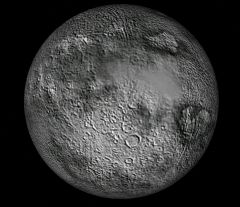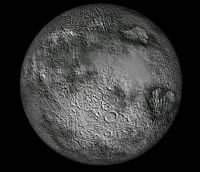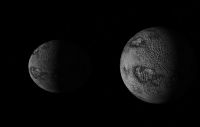90 Antiope
| 90 Antiope | |
|---|---|

| |
| S/2000 (90) 1 (left) and 90 Antiope (right) from MainBeltAsteroids.zip in Orbiter 2002P3 | |
| Designation | |
| Name | 90 Antiope |
| Reference body | Sun |
| Planetary mean orbits | |
| Epoch | 2003.441 |
| Semimajor axis (a) | 473 347 415 620 m |
| Eccentricity (e) | 0.154810771 |
| Inclination (i) | 2.218798084° (0.038725332 radian) |
| Longitude of the ascending node (LAN, ☊) | 70.35644109° (1.227951547 radian) |
| Longitude of periapsis (ϖ) | 311.6958182° (5.440118292 radian) |
| Mean longitude (L) | 520.6683312° (9.08737669 radian) |
| Selected physical parameters | |
| Mean radius | 42500 km |
| Mass | 4×1017 kg |
| Rotation elements | |
| SidRotPeriod | 59432 seconds (16.509 hours) |
| SidRotOffset | 0 |
| Obliqutiy | 0 |
| LAN | 0 |
| Note | *Elements given are from 90 Antiope.cfg (MainBeltAsteroids.zip) |
90 Antiopeis a double asteroid with S/2000 (90) 1 in the main asteroid belt between Mars and Jupiter, and was discovered on 1 October 1866 by Robert Luther. The name comes from [[w:Greek mythology|Greek mythology. 90 Antiope was considered a single body until August 2000 when it was discovered to be two almost identical bodies, the mass differing by less than 2.5%. Antiope is now attributed to the larger body and the smaller body is desgnated as S/2000 (90) 1.
Antiope in Orbiter
90 Antiope was first introduced with the release of MainBeltAsteroids.zip in May 2003. Since Orbiter is not written for two bodies revolving about a gravity center, S/2000 (90) 1 is configured to revolve as a standard satellite about Antiope in this release. Note that the landing surface as given in the config file is spherical, but the visual of these bodies are not, if you land, you will likely be above or below the visual surface.
| Add-on | Source | Version | Author | Type | Release Date | Compatibility | Wiki article |
|---|---|---|---|---|---|---|---|
| Main Belt Asteroids v1.0 | O-F Resources | v1.0 | Unknown OHM Addon Developer | Scenery | 14 May 2003 | ||
See also
Gallery
Very Large Telescope images of 90 Antiope and S/2000 (90) 1 in 2004
| edit The Solar System | |
|---|---|
| Central star |
Sun (Sol) |
| Planets |
Mercury - Venus - Earth - Mars - Jupiter - Saturn - Uranus - Neptune |
| Natural satellites |
Moon - Phobos - Deimos - Io - Europa - Ganymede - Titan - more... |
| Add-ons |
Planets - Dwarf Planets - Small objects - Natural satellites - Alternative star systems |


